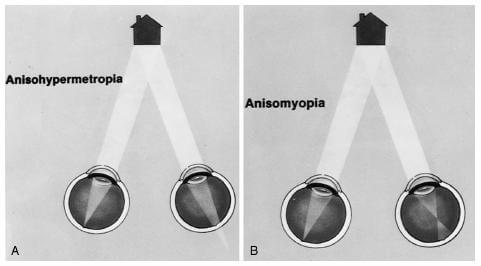The final anisometropia correction can be performed by corneal surgery or by artificial lens implant
What does anisometropia mean?
Anisometropia is a condition in which the refractive power of the two eyes not the same. Namely, one eye can be normal, and the other eye can be myopic or hyperopic. There are cases in which both eyes are either myopic or hyperopic, but with a difference of more than 2 diopters between them. There are rare case when one eye is myopic and the other one is hyperopic.
Which are the effects on the vision?
Normal, binocular vision requires a good and equal vision of the eyes, the alignment of the axes in both eyes and their coordinated movement.
If there is a difference of dioptric power between the 2 eyes, the images that reach the brain will be different (a clearer image from the eye with lower diopter and a more blurred image from the eye with higher dioptre). The overlapping of these unequal or overlapping images in the brain creates discomfort, so that the brain suppresses the blurry image (or ignores it), developing amblyopia (the higher diopter eye becomes lazy).

Can the vision be corrected?
It is important that any refractive errors, including anisometropia, to be detected and treated as soon as possible, during early childhood.
First, it is required to wear an appropriate optical correction (glasses or contact lenses). The amblyopia treatment has to be started as soon as possible, the treatment consisting in stimulating of the “lazy” eye, by covering the better vision eye.

Is it difficult to treat?
To obtain a proper correction, when there’s a difference of more than 4 dioptres between the two eyes, is challenging.
This happens because the images from both eyes (by wearing glasses or contact lenses), even if they are clear, have different sizes (condition defined as aniseikonia).
For example, a 0 diopter eye has a normal image, the other eye with – 5 diopters, by wearing appropriate contact lenses, has a clear image but smaller than the image of the first eye. The overlap in the brain of the 2 images of unequal size is very disturbing for the brain . So, in many cases the patients give up wearing optical correction, thus relying on the vision of a single eye (usually the eye with better vision).

Which is the best treatment method?
Taking into account the difficulties faced in getting a good and equal vision of both eyes by wearing glasses or contact lenses, the surgical treatment aims to equalize both eyes diopters, it does not have an aesthetic purpose, but a medical one.
The final correction of the anisometropia can be performed either by laser surgery, or by artificial lens implant. The surgical treatment is indicated in adults, the best method being established by the ophthalmologist, according to a series of specific investigations.
In order for these interventions to have a greater chance of success, an important condition is that the eye undergoing surgery not to be amblyopic (lazy). Although, even in this case, outstanding visual results can be achieved.
What are anisometropia correction methods?
Anisometropia can be corrected by:
Lasek/PRK
PRK / Lasek are two similar refractive laser techniques using both an Excimer Laser. They are based on the property of the corneal epithelium (the first layer of the cornea) to regenerate naturally after being partially removed. Subsequently, the cornea is reshaped by the laser, thus obtaining the correction of the diopters. In case of LASEK, the removed epithelium is repositioned after the laser treatment, being gradually replaced by a new epithelium. In PRK a therapeutic contact lens is worn for 7 days in order to facilitate the healing of the surface.
Find more details here
FemtoLasik
FemtoLASIK is a modern refractive laser technique which requires two types of laser: the Femtosecond laser and the Excimer. The diopters reduction laser surgeries are a quick treatment, customized, silent, odorless independent of the environment, with an accuracy of less than one micron, by following the corneal curvature.
Find more details here
ReLEx SMILE
It’s a new minimally invasive refractive procedure, which represents the third generation of laser refractive surgery. The great innovation consists of performing the surgery without a flap (as in all the LASIK techniques) and without removing of the corneal epithelium (as in the PRK and LASEK techniques). In one single step, the femtosecond laser creates a refractive lenticule and a thin tunnel in the corneal structure through which the lenticule is extracted. No ablation or flap!
Find more details here
Refractive lens exchange
It is a surgical technique similar to cataract surgery where the lens inside the eye, also called crystalline lens, is replaced with a multifocal artificial lens with a diopter adjusted to the parameters of the respective eye. Therefore, after the surgery, the patient no longer needs glasses. After implantation, the artificial lens remains functional for the rest of the patient’s life.
Find more details here
Visian Implantable Collamer Lens (ICL)
The technique involves positioning an artificial lens inside the eye, through a small incision that does not require suture, behind the iris (the colored part of the eye) and in front of the natural lens. This new optical system focuses the rays of light on the retina into a clear image. Find more details here

